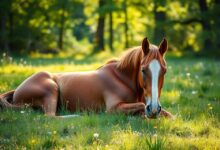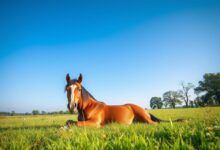Understanding Horse Face Markings Explained
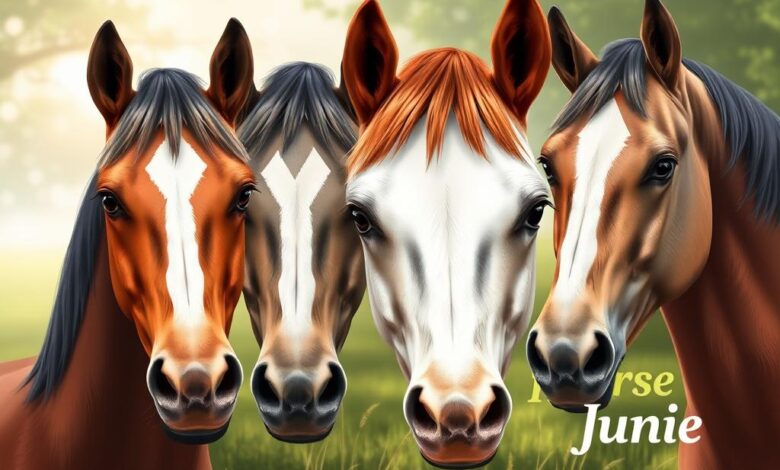
Ever thought about how a small mark on a horse’s face can reveal a lot? It’s not just about looks. It’s key to knowing who our horses are and what makes them special.
Horse face markings like stars, snips, stripes, blazes, or bald faces tell us a lot. They show what breed a horse is and help identify it. These equine facial markings are not just for looks. They help prove who owns a horse and how to care for it. Knowing about these markings can also tell us about a horse’s value.
Key Takeaways
- Horses feature various face markings: star, snip, stripe, blaze, and bald face.
- Leg markings extend with variations like coronet, pastern, and stocking.
- Markings can significantly impact a horse’s identification and evaluation.
- Understanding genetics behind these patterns enhances horse care and management.
- Recognizing unique facial patterns is vital for horse enthusiasts and owners.
The Importance of Horse Face Markings in Identification
Understanding horse face markings is key for identifying horses. Each horse has unique facial features, like no two snowflakes. These patterns help us identify horses easily. They are important for health records and tracing lineage.
Recognizing Unique Patterns
Horses have different face colorings that make them unique. You might see stars, snips, or blazes on their faces. Some horses have more than one marking, like a star and strip.
Bald faces, with wider white markings, are common in Paints and Clydesdales. Knowing these patterns is important for their health and registration. It helps in their ongoing care and assessment.
Understanding Breed Characteristics
Facial markings can show a horse’s breed. For example, Clydesdales have specific white patches. Knowing these traits helps us appreciate different breeds.
It also supports education on breed heritage. The future of identifying horses looks bright. New technologies like RFID and iris biometrics will make identification easier and more accurate.
Common Types of Face Markings in Horses
Knowing about horse facial markings helps us see the unique traits in our equine friends. Each marking adds to a horse’s beauty and makes it special. In our guide, we look at the most common markings, helping fans see these special features.
Star, Snip, and Blaze
The star, snip, and blaze are well-known markings. A star is a white spot on the forehead, from a small sprinkle to a big area. The snip is between the nostrils, from a small dot to a wide mark.
The blaze goes from the forehead to the nostrils, often wider than a stripe. It stands out against the horse’s coat.
Stripe and Bald Face
The stripe is a thin white line on the nose bridge. It’s clear and adds beauty. A bald face has a lot of white on the head, with color around the eyes and muzzle.
Some bald-faced horses have a dark area on their muzzle, called a moustache. This adds to their appeal.
Uncommon Variations
There are also uncommon variations in horse markings. These come from unique genetic mixes. While common markings are a good start, the variety is endless and fascinating.
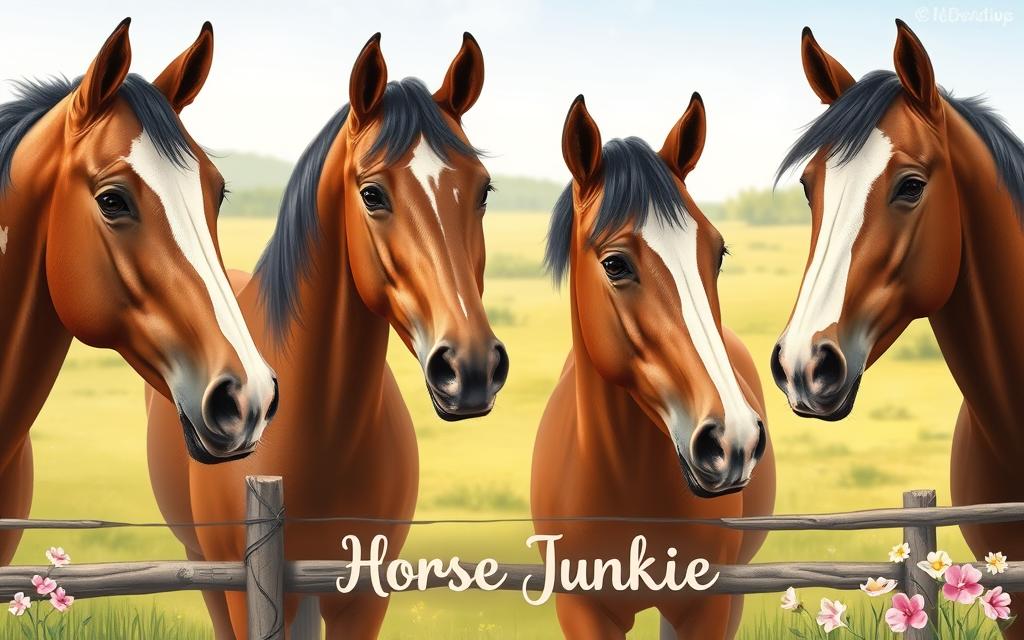
How Face Markings Influence Horse Evaluation
Face markings play a big role in evaluating horses. They affect how horses look in competitions and their value when sold. Knowing about these markings is key for anyone who loves horses. A horse’s markings can make them more appealing in different situations.
Aesthetics in Competition
Judges at competitions pay close attention to a horse’s face markings. They see how special patterns can make a horse look beautiful. Markings like stars, snips, or blazes not only identify a horse but also add to their look.
A horse with striking face markings might do better in competitions. They could get higher scores and more recognition.
Impact on Resale Value
The value of a horse can change based on their face markings. Buyers often want specific markings that fit their taste or breed standards. A horse with attractive markings might sell for more than one with common or less appealing patterns.
Understanding what buyers want is important for sellers. It helps them attract more buyers and get better prices.
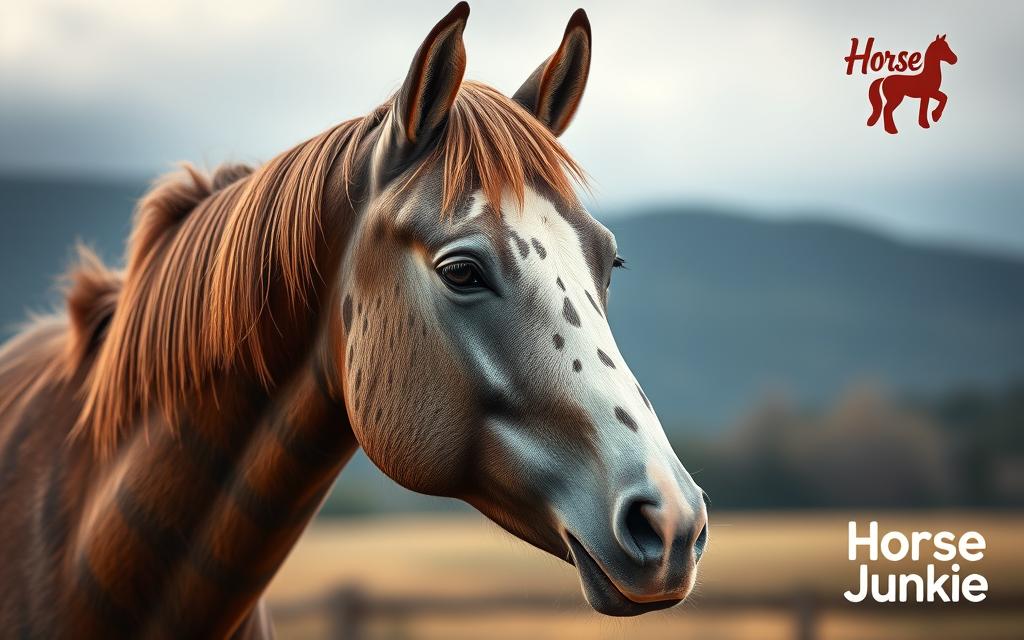
The Genetics Behind Face Markings
The genetics of horse face markings show a complex mix of heredity and color genes. Specific patterns and colors come from traits passed down through generations. This is thanks to dominant and recessive genes. Recent studies have uncovered the intricate details of this genetic system.
Heredity and Inheritance Patterns
Researchers found that certain genes on the genome control face and leg markings. They studied over 1,000 Franche-Montagne horses to understand this. They found three main genes that affect the amount of white markings.
This shows how genetics can influence a horse’s look and breed identity. Breeders and horse owners worked together in this research. Their efforts show the value of community in studying equine genetics.
Color Genes and Marking Variability
The study used a new computer method to analyze these genetic codes. It gave us new insights into color genes in horses. Genome-wide analysis found seven specific locations linked to these traits.
The results have wider implications and sparked talks about reducing markings for looks and history. As we study more horse breeds, we appreciate the genetic diversity in horse face markings.
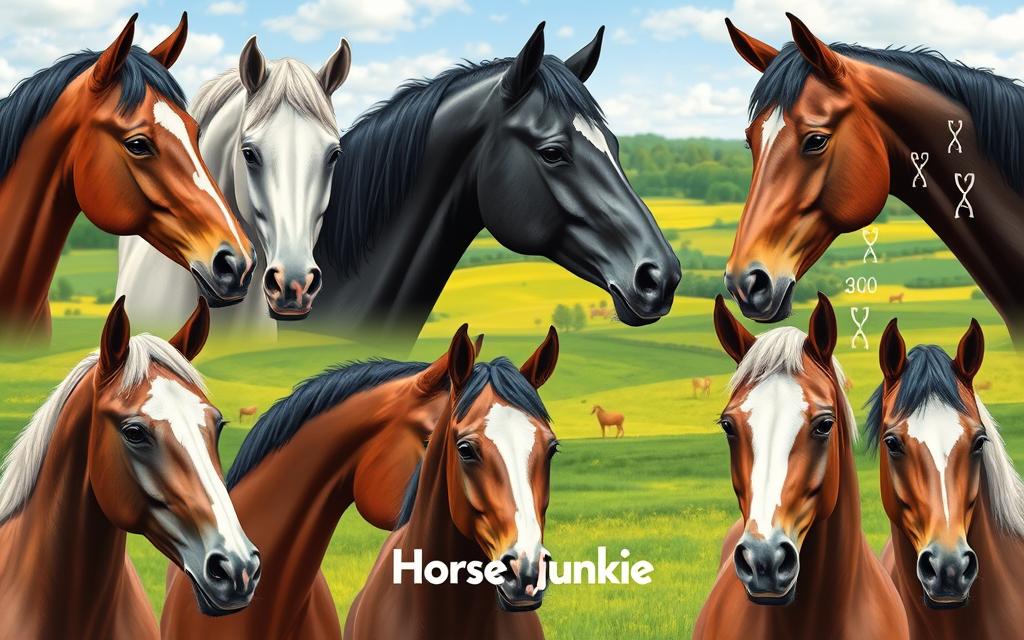
Regional Variations in Face Markings
Exploring the diversity in horse face markings by region offers a peek into the world of equine beauty. These markings show how different breeding practices shape horses. They also reveal cultural influences, making certain traits unique to specific breeds.
North American Insights
In North America, some patterns stand out in horse facial markings. Breeds like the Thoroughbred and Paint often have stars, blazes, or snips. These markings help identify a horse’s lineage and traits.
The bald face is common here. This is due to the growth of ranching and equestrian sports across the continent.
European Trends
European horse breeds have their own unique patterns. For instance, Friesians have distinctive face markings. Draft breeds show different patterns by region.
These patterns show the horse breeding community’s focus on both function and beauty. They highlight the cultural importance of each marking in Europe.

Evaluating Markings for Breed Standards
When we look at horse markings, we focus on breed standards. These standards are key for successful horse facial marking registration. Each breed has its own rules for facial characteristics. These rules help keep the breed’s integrity.
Markings and Registration
During the registration process, registries check the horse’s markings closely. This creates a clear way to identify horses. They look at:
- Distinctive facial markings, such as snips, blazes, and stars
- Leg markings, including socks and pasterns
- Overall coat color and pattern consistency with breed standards
Breed-Specific Patterns
Every horse breed has its own marking patterns. These patterns help identify mixed breeds. For example, the European Brabant breed has rules for blazes and facial markings. But it doesn’t allow full white faces or body markings.
Evaluating horse facial patterns helps follow breed standards. It also helps us understand what makes each breed unique.
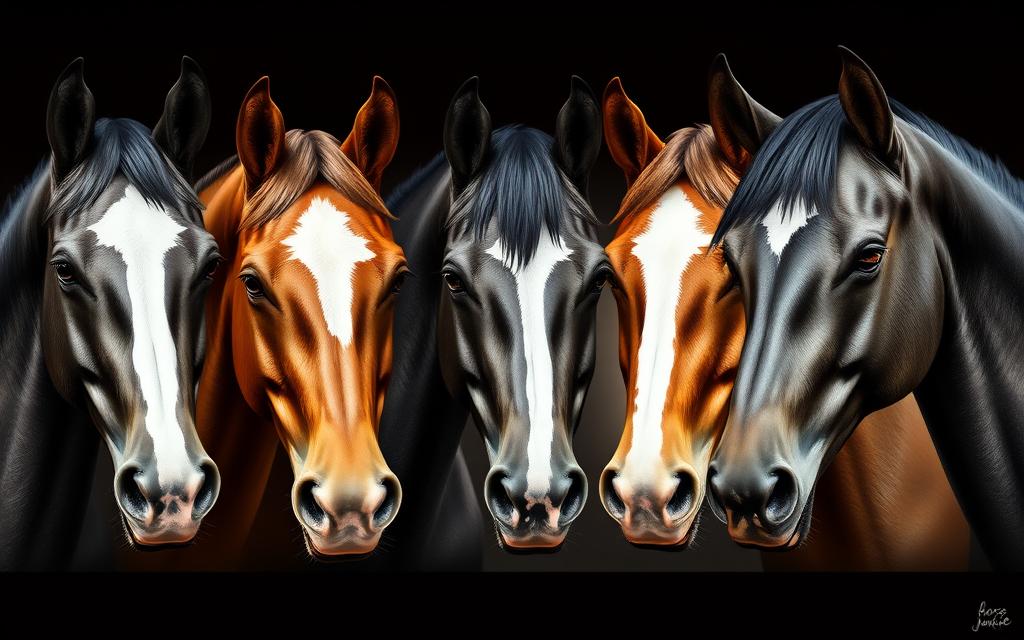
Caring for Horses with Distinct Markings
Caring for horses with unique face markings needs careful grooming. We focus on keeping these special features healthy and bright. When grooming, we must also think about the special needs of horses with white markings. This is to prevent sunburn and other skin problems.
Grooming Considerations
Grooming horses with special markings requires extra care. Here are some important tips:
- Wet grooming tools before brushing to avoid hurting the horse and to remove dirt gently.
- Use soft brushes on sensitive spots, especially where markings might cause pain or irritation.
- Watch for muted colors in markings; they can hide dirt well, so cleaning them regularly is important.
Skin Health and Marking Exposure
Protecting a horse’s skin is key to their health. Horses with white markings or “Medicine hat” patterns need extra care:
- Put sunscreen on exposed areas, especially during the sunniest times.
- Look for signs of irritation or sunburn, especially in horses that are outside a lot.
- Choose gentle grooming products that are right for sensitive skin.
By paying attention to grooming and skin health, we can make horses with markings look their best. This care helps them feel comfortable and proud of their unique features.
Documenting and Tracking Face Markings
Managing horses well means keeping track of their face markings. This helps us identify them and watch for any changes. Using photos and keeping records helps us capture important details for health checks and tracing their family lines.
Photography and Record Keeping
Regular photos are key for anyone caring for horses. Keeping detailed records helps us see how facial markings change as horses grow. We can build a visual collection of each horse’s unique face, spotting any unusual changes.
- Date and age of the horse
- Detailed photographs from multiple angles
- Notes on any changes observed in markings
Technology in Marking Identification
Technology has changed how we identify horse markings. Tools like facial recognition software make tracking easier and more accurate. This tech helps reduce mistakes and makes managing horses more efficient, whether in breeding or competitions. It’s a big help for both horses and their handlers.
![]()
The Role of Face Markings in Equine Culture
Horse face markings are deeply rooted in equine culture. They are found in folklore and traditions worldwide. These markings are more than just looks; they hold meanings that change by region and community. Learning about their cultural significance helps us see horses in a new light.
Folklore and Myths Surrounding Markings
For centuries, cultures have shared stories about folklore related to horse markings. Many believe certain markings bring luck or protection to horses and riders. These tales often feature horses with unique markings as magical beings with special powers.
These stories fit into equine myths that say markings are omens. They show a horse’s potential to excel in certain areas.
Symbolism in Different Cultures
The horse face markings cultural significance changes a lot between cultures. In Native American traditions, special markings mean a strong spirit or a deep connection to the earth. On the other hand, in European customs, unique markings show a horse’s noble background or good fortune. This knowledge deepens our bond with horses, showing the deep meanings behind their striking features.
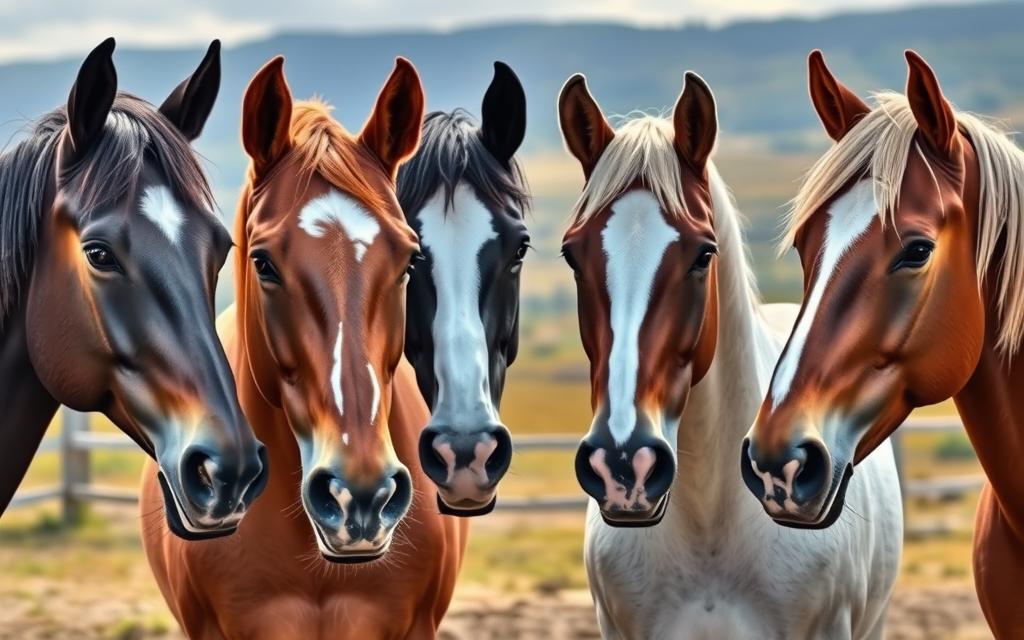
Conclusion: Embracing the Diversity of Face Markings
In the world of horses, we see a wide range of face markings. These markings make each horse special and strengthen our bond with them. Every horse’s face tells a story, showing its heritage and character.
By celebrating these unique markings, we honor what makes each horse different. This makes every horse truly special.
Celebrating Our Unique Horses
Learning about face markings helps us connect with horses on a deeper level. As fans of horses, it’s important to value and keep this diversity alive. Appreciating the variety of markings shows our respect and admiration for them.
This appreciation improves how we care for, breed, and identify horses. It makes our time with them even more rewarding.
Encouraging Awareness in Horse Enthusiasts
We should spread the word about the beauty and importance of horse face markings. Each marking tells a unique story and connects us to the horse’s history. When we all appreciate these markings, our love for horses grows stronger.
This unity in our love for horses helps us support and honor them. It brings us closer together in our shared passion for these amazing animals.
FAQ
What are horse face markings and why are they important?
How can I identify different horse face markings?
Do specific horse breeds have unique face markings?
How do face markings affect a horse’s value in competitions?
What is the genetic basis of horse face markings?
Are there regional differences in horse face markings?
How are horse face markings evaluated for breed registration?
What grooming tips should I follow for horses with distinctive face markings?
How can I track and document my horse’s face markings?
What cultural significance do horse face markings hold?
Source Links
- Horse Markings: Your Cheat Sheet on What You Need to Know! –
- Horse Face and Leg Markings
- Recognize Horse Facial Markings Such as Blazes, Stars and Snips
- NVAP Reference Guide: Equine Identification | Animal and Plant Health Inspection Service
- Horse Face and Leg Markings
- Horse Markings: Your Cheat Sheet on What You Need to Know! –
- Intro to Face Markings
- Markings of Horses by Dr Sunil kumar
- Features of coat color and markings and impact of dun factor on Vyatka horse breed
- What’s a Whorl? – Teddie Ziegler Horsemanship
- Genetics Behind Horses’ Face and Leg Markings Studied
- Genetics Behind Horses’ Face and Leg Markings Studied
- Microsoft Word – Identification of horses2007_print.doc
- Identifying Horse Parts and Markings
- Horse Markings – Guide to Equine Beauty, Read Now
- Thoroughbred Colors and Markings
- Breed Standards | European Brabant
- Horse Markings – Guide to Equine Beauty, Read Now
- horses with unique coloring/facial markings – Page 26 – Horse Racing Forum
- Unlocking the Enchanting Beauty of White Markings in Horses: Stars, Sn
- Horse Terminology: Describing Horses Correctly
- horses with unique coloring/facial markings – Page 76 – Horse Racing Forum
- Markings are all just minimal patterns, right?
- Unlocking the Enchanting Beauty of White Markings in Horses: Stars, Sn
- Wonders Behind Horse Coat Colors
- Barbie’s Expanding Inclusivity
- Romaine Brooks: Embracing Diversity



